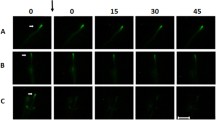Abstract
The ultrastructure of the hyphal tips of wild type and spreading colonial mutants (spco) ofNeurospora crassa was studied. The results suggest that the observed concentration of vesicles in the hyphal tips of wild type, cot 3, spco 1 and spco 12 is a consequence of the fact that in each strain the number of vesiclesper unit length of the long axis the hypha remains approximately constant. Spco 9 differed from the other strains in that a proportionally longer region of its hyphal tips contained a high concentration of vesicles.
There was a direct relationship between the length of the tapered region of the hyphal tips of the various strains and their extension rates; the tapered region of a tip probably represents the extension zone of the hypha and varied in length from about 2 μm (spco 12) to about 33 μm (wild-type).
Similar content being viewed by others
References
Bartnicki-Garcia, S.: Fundamental aspects of hyphal morphogenesis. In: Microbial differentiation, J. M. Ashwoth, J. E. Smith, Eds., pp. 245–267. Cambridge: University Press 1973
Burnett, J. H.: Fundamentals of mycology. London: Edw. Arnold 1968
Gooday, G. W.: An autoradiographic study of hyphal growth of some fungi. J. gen. Microbiol.67, 125–133 (1971)
Green, P. B.: Cell morphogenesis. Ann. Rev. Plant Physiol.20, 365–394 (1969)
Grove, S. N., Bracker, C. E.: Protoplasmic organization of hyphal tips among fungi: Vesicles and Spitzenkörper. J. Bact.104, 989–1009 (1970)
Hunsley, D.: Apical wall structure in hyphae ofPhytophthora parasitica. New Phytol.72, 985–990 (1973)
Ingold, C. T.: The reaction of fungi to light and the problem of photoreception. In: Biological receptor mechanisms, pp. 154–169, S.E.B. Symposia. Cambridge: University Press 1962
Reynolds, E. S.: The use of lead citrate at high pH as an electron opaque stain in electron microscopy. J. biophys. biochem. Cytol.17, 208–212 (1963)
Trinci, A. P. J.: Growth of wild type and spreading colonial mutants ofNeurospora crassa in batch culture and on agar medium. Arch. Mikrobiol.91, 113–126 (1973)
Trinci, A. P. J., Banbury, G. H.: A study of the growth of the tall conidiophores ofAspergillus giganteus. Trans. Brit. mycol. Soc.50, 525–538 (1967)
Trinci, A. P. J., Banbury, G. H.: Phototropism and light growth responses of the tall conidiophores ofAspergillus giganteus. J. gen. Microbiol.54, 427–438 (1968)
Trinci, A. P. J., Collinge, A. J.: Structure and plugging of septa of wild type and spreading colonial mutants ofNeurospora crassa. Arch. Mikrobiol.91, 355–364 (1973)
Vogel, H. J.: A convenient medium for Neurospora (medium N). Microbiol. Genet. Bull.13, 42 (1956)
Author information
Authors and Affiliations
Rights and permissions
About this article
Cite this article
Collinge, A.J., Trinci, A.P.J. Hyphal tips of wild-type and spreading colonial mutants ofNeurospora crassa . Arch. Microbiol. 99, 353–368 (1974). https://doi.org/10.1007/BF00696249
Received:
Issue Date:
DOI: https://doi.org/10.1007/BF00696249




